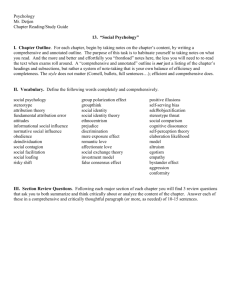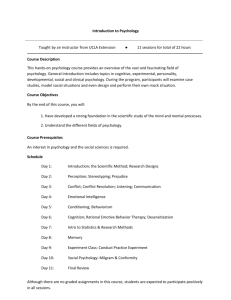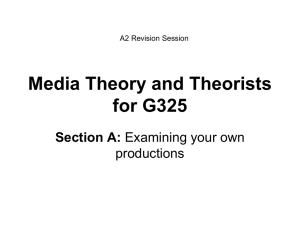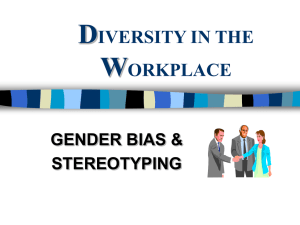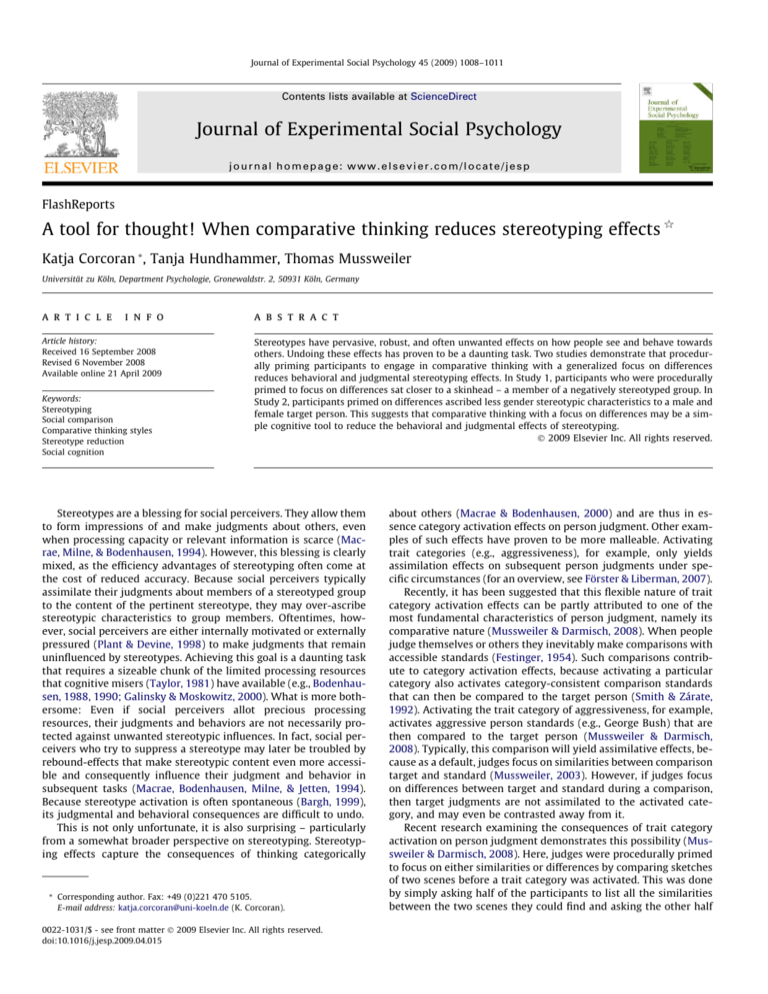
Journal of Experimental Social Psychology 45 (2009) 1008–1011
Contents lists available at ScienceDirect
Journal of Experimental Social Psychology
journal homepage: www.elsevier.com/locate/jesp
FlashReports
A tool for thought! When comparative thinking reduces stereotyping effects q
Katja Corcoran *, Tanja Hundhammer, Thomas Mussweiler
Universität zu Köln, Department Psychologie, Gronewaldstr. 2, 50931 Köln, Germany
a r t i c l e
i n f o
Article history:
Received 16 September 2008
Revised 6 November 2008
Available online 21 April 2009
Keywords:
Stereotyping
Social comparison
Comparative thinking styles
Stereotype reduction
Social cognition
a b s t r a c t
Stereotypes have pervasive, robust, and often unwanted effects on how people see and behave towards
others. Undoing these effects has proven to be a daunting task. Two studies demonstrate that procedurally priming participants to engage in comparative thinking with a generalized focus on differences
reduces behavioral and judgmental stereotyping effects. In Study 1, participants who were procedurally
primed to focus on differences sat closer to a skinhead – a member of a negatively stereotyped group. In
Study 2, participants primed on differences ascribed less gender stereotypic characteristics to a male and
female target person. This suggests that comparative thinking with a focus on differences may be a simple cognitive tool to reduce the behavioral and judgmental effects of stereotyping.
Ó 2009 Elsevier Inc. All rights reserved.
Stereotypes are a blessing for social perceivers. They allow them
to form impressions of and make judgments about others, even
when processing capacity or relevant information is scarce (Macrae, Milne, & Bodenhausen, 1994). However, this blessing is clearly
mixed, as the efficiency advantages of stereotyping often come at
the cost of reduced accuracy. Because social perceivers typically
assimilate their judgments about members of a stereotyped group
to the content of the pertinent stereotype, they may over-ascribe
stereotypic characteristics to group members. Oftentimes, however, social perceivers are either internally motivated or externally
pressured (Plant & Devine, 1998) to make judgments that remain
uninfluenced by stereotypes. Achieving this goal is a daunting task
that requires a sizeable chunk of the limited processing resources
that cognitive misers (Taylor, 1981) have available (e.g., Bodenhausen, 1988, 1990; Galinsky & Moskowitz, 2000). What is more bothersome: Even if social perceivers allot precious processing
resources, their judgments and behaviors are not necessarily protected against unwanted stereotypic influences. In fact, social perceivers who try to suppress a stereotype may later be troubled by
rebound-effects that make stereotypic content even more accessible and consequently influence their judgment and behavior in
subsequent tasks (Macrae, Bodenhausen, Milne, & Jetten, 1994).
Because stereotype activation is often spontaneous (Bargh, 1999),
its judgmental and behavioral consequences are difficult to undo.
This is not only unfortunate, it is also surprising – particularly
from a somewhat broader perspective on stereotyping. Stereotyping effects capture the consequences of thinking categorically
* Corresponding author. Fax: +49 (0)221 470 5105.
E-mail address: katja.corcoran@uni-koeln.de (K. Corcoran).
0022-1031/$ - see front matter Ó 2009 Elsevier Inc. All rights reserved.
doi:10.1016/j.jesp.2009.04.015
about others (Macrae & Bodenhausen, 2000) and are thus in essence category activation effects on person judgment. Other examples of such effects have proven to be more malleable. Activating
trait categories (e.g., aggressiveness), for example, only yields
assimilation effects on subsequent person judgments under specific circumstances (for an overview, see Förster & Liberman, 2007).
Recently, it has been suggested that this flexible nature of trait
category activation effects can be partly attributed to one of the
most fundamental characteristics of person judgment, namely its
comparative nature (Mussweiler & Darmisch, 2008). When people
judge themselves or others they inevitably make comparisons with
accessible standards (Festinger, 1954). Such comparisons contribute to category activation effects, because activating a particular
category also activates category-consistent comparison standards
that can then be compared to the target person (Smith & Zárate,
1992). Activating the trait category of aggressiveness, for example,
activates aggressive person standards (e.g., George Bush) that are
then compared to the target person (Mussweiler & Darmisch,
2008). Typically, this comparison will yield assimilative effects, because as a default, judges focus on similarities between comparison
target and standard (Mussweiler, 2003). However, if judges focus
on differences between target and standard during a comparison,
then target judgments are not assimilated to the activated category, and may even be contrasted away from it.
Recent research examining the consequences of trait category
activation on person judgment demonstrates this possibility (Mussweiler & Darmisch, 2008). Here, judges were procedurally primed
to focus on either similarities or differences by comparing sketches
of two scenes before a trait category was activated. This was done
by simply asking half of the participants to list all the similarities
between the two scenes they could find and asking the other half
K. Corcoran et al. / Journal of Experimental Social Psychology 45 (2009) 1008–1011
to list all the differences. Previous research has demonstrated that
this task activates an informational focus on either similarities or
differences that carries over to a subsequent person judgment task
(Mussweiler, 2001). These person judgments were assimilated to
the activated trait category if participants had been procedurally
primed to focus on similarities, but not if they had been primed
to focus on differences. A focus on differences thus countered the
typical assimilative consequences of trait category activation. This
finding extends earlier work examining how comparison thinking
influences trait category priming effects (e.g., Stapel & Koomen,
2001). Whereas this earlier research suggested that comparative
thinking per se may work against assimilative priming effects,
these more recent findings, demonstrate that this is only true for
one particular type of comparative thinking, namely comparisons
that involve a focus on differences.
In much the same way, a comparison focus on differences may
also work against the assimilative effects of social category activation and may thus reduce stereotyping effects. Just as the activation of a trait category activates consistent standards, the
activation of a social category is likely to activate stereotypic category members that are then compared to a target person (Smith &
Zárate, 1992). If this comparison involves a focus on differences,
the previously described research suggests (Mussweiler & Darmisch, 2008) that stereotyping effects may be reduced. The present
research was designed to examine this possibility. To do so, we
procedurally primed participants to focus on similarities or differences before they engaged in a stereotyping task. Study 1 examined how these alternative comparison foci influenced
participants’ behavior towards the member of a stereotyped group.
Study 2 examined how these foci influenced judgments of group
members. In both cases, we expected that a comparison focus on
differences would reduce stereotyping effects.
Study 1
In our first experiment, we procedurally primed (Smith, 1994)
participants with a focus on similarities vs. differences (Mussweiler, 2001; Mussweiler & Darmisch, 2008) and then assessed their
behavior towards a member of a stereotyped group. Specifically,
we observed how far participants seated themselves from a chair
that appeared to be occupied by a skinhead (Macrae, Bodenhausen,
et al., 1994). If a focus on differences reduces the extent to which
negative stereotypic attributes are ascribed to the target person,
this should reduce the tendency for participants to put distance between themselves and the skinhead, leading them to sit closer to
him.
Methods
We recruited 36 university students as participants and offered
them a compensation of € 6.
The experiment was modeled after the classic study by Macrae,
Bodenhausen, and colleagues (1994). Participants completed three
different tasks that were ostensibly unrelated. First, participants
worked on the stereotype activation task. Here, they were given
a picture of a skinhead and asked to take 5 min to describe a typical
day in his life.
In the second, the procedural priming task, we manipulated
participants’ focus on similarities vs. differences (Mussweiler &
Darmisch, 2008, see also Mussweiler, 2001). All participants received sketches of two scenes depicting urban squares in the
19th century. We instructed about half of our participants to write
down as many similarities and the other half to write down as
many differences between the two scenes as they could find. Previous research (Mussweiler, 2001) has established that this task in-
1009
duces a focus on similarities vs. differences that carries over to
subsequent tasks.
Participants were then informed that the final task would be
administered in a different lab. While leading them to a nearby
waiting room, the experimenter explained that they would be
asked to take off their shoes and socks for a biopsychological study
on temperature perception with one’s feet In the waiting room, seven chairs stood along the wall. The second-closest chair to the
door was ostensibly occupied by another person. A bomber jacket
was hanging over the back of the chair and a pair of white laced
military boots with sports socks was lying in front of it. These
items are prototypical of the standard skinhead attire. As soon as
participants took a seat, the experimenter ended the study and debriefed participants using funneled debriefing. Here, participants
were probed for whether they saw a connection between the different tasks, and whether they had seen the target person as
belonging to a social category other than skinhead.
In sum, Study 1 is based on a single factor (similarity vs. dissimilarity focus) between-subjects design.
Results and discussion
The funneled debriefing revealed that four participants saw the
target person as a left-wing punk – a category associated with
characteristics that are opposite to those of the skinhead category.
Given that – as is true for most items that could be realistically
used in our experimental setup – the bomber jacket and military
boots are not exclusively associated with a single social category,
such alternative categorizations are inevitable. Five participants
saw a connection between priming and seating task. These participants were excluded from further analyses, leaving a final sample
of 27 participants.
Our central dependent variable is participants’ seating position.
We coded participants’ choice of chairs such that 1 indicates one of
the chairs next to, and 5 the chair furthest away from, the chair
occupied by the skinhead, who presumably may return at any moment. If participants are less likely to stereotype the skinhead
when focused on differences than when focused on similarities,
this should be apparent in their seating choice. The results are consistent with this reasoning. Participants primed to focus on differences sat closer to the chair of the skinhead (M = 2.31, SD = 1.11)
than did participants primed to focus on similarities (M = 3.29,
SD = 1.2), t(25) = 2.19, p < .04, d = 0.85.
These findings suggest that a difference focus may reduce
behavioral stereotyping effects. Stereotyping, however, is not only
apparent in how we behave towards others, but also in how we
judge and evaluate them. Study 2 was designed to examine
whether judgmental stereotyping effects may be similarly reduced
by a difference focus.
Study 2
To do so, we again induced participants to focus on similarities
vs. differences with a procedural priming task. Subsequently, they
judged a male vs. female target person with respect to a number of
characteristics that are closely related to the gender stereotype.
We hypothesized that participants who focused on differences
would see and judge the target persons in less stereotypic ways.
Methods
We recruited 91 male and female university students as participants and offered them a chocolate bar as compensation.
Upon arrival in the lab, participants were asked to work on two
separate tasks. The first task was the procedural priming task,
1010
K. Corcoran et al. / Journal of Experimental Social Psychology 45 (2009) 1008–1011
which was identical to the one used in the Study 1. The second task
was the stereotyping task. Here participants were instructed to assume the role of a personnel manager and to evaluate whether an
employee was qualified for an IT-training program based on some
general information (e.g., short CV, comments from coworkers). For
about half of the participants, the employee was female (‘‘Christiane Müller”) for the other half he was male (‘‘Christian Müller”).
After forming an impression of the employee, participants were
asked to judge him/her on nine dimensions including four critical
ones. The critical attributes were closely related to stereotypes
about male (technically skilled, logically skilled) and female (sympathetic, and compassionate) professional skills. They appeared in
the 3rd, 4th, 6th, and 8th position and were interspersed with stereotype-unrelated dimensions (e.g., enthusiastic). Participants
made their ratings for each attribute on a 9-point rating scale ranging from 1 (a little) to 9 (very). After completion of this task, participants were fully debriefed using a funneled debriefing,
thanked for their participation, and offered their compensation.
None of the participants were aware of the actual connection between the ostensibly unrelated tasks.
In sum, Study 2 is based on a 2 (similarity vs. difference
focus) 2 (female vs. male target) between subjects experimental
design.
Results and discussion
We combined participants’ judgments on the stereotypic
dimensions into one stereotypicality index by calculating the mean
of the four attribute ratings (after reverse-scoring ratings for the
stereotypically male dimensions). Thus, higher values on this index
indicate that the target person was ascribed more stereotypically
female skills and fewer stereotypically male skills. An analysis of
ratings on the stereotype-unrelated dimensions revealed that they
were uninfluenced by the gender of the target and the procedural
priming, all F’s < 1.
However, the procedural priming influenced participants’ rating
on the stereotypic dimensions. As inspection of Fig. 1 reveals, participants primed with a similarity focus judged the female target
(M = 5.61, SD = 0.58) to be more stereotypic female than the male
target (M = 5.12, SD = 0.71), t(87) = 2.49, p < .02. For participants
primed with a dissimilarity focus, this was not the case
(M = 5.16, SD = 0.42 vs. M = 5.25, SD = 0.78), t < 1. This pattern produced a significant interaction effect in a 2 (similarity vs. difference
focus) 2 (female vs. male target) ANOVA using the stereotypicality index as the dependent measure, F(1, 87) = 4.91, p < .03,
g2p ¼ :05; F < 2.1, p > .24 for remaining effects. Including participant
gender as a factor in this analysis did not change the results, and no
effect including gender reached significance (all Fs < 1).
These findings demonstrate that an induced focus on differences eliminates the judgmental consequences of activated
stereotypes.
General discussion
These two studies provide converging support for the notion
that a comparison focus on differences may reduce the judgmental
and behavioral consequences of stereotyping. Participants who
were procedurally primed to focus on differences sat closer to a
member of a negatively stereotyped group (skinhead) and ascribed
less gender-stereotypic characteristics to a male and female target
person. This finding seems particularly noteworthy because stereotyping effects are typically fairly robust and difficult to correct for.
The present research extends previous findings examining the
influence of different mindsets on stereotype activation (Sassenberg & Moskowitz, 2005). Specifically, this earlier research demonstrates that activating a broad mindset of creative thinking reduces
the extent to which stereotypic associations are activated automatically. Although in this research a broad mindset of creative thinking was activated by simply asking participants to describe
situations in which they had behaved creatively, one may speculate that among other things, this activated mindset also involves
a focus on differences. The present studies go beyond this earlier
demonstration, by (1) activating a specific information processing
mechanism, namely a focus on differences, rather than a broad
mind-set, (2) using a procedural priming manipulation to directly
induce this difference focus, and (3) assessing consequences for
stereotype use on the level of judgments and behavior rather than
mere stereotype activation on the level of semantic associations.
In the present research, we used a procedural priming task to
directly induce a generalized focus on similarities vs. differences.
These respective foci, however, can also be induced by unobtrusive
environmental cues. For example, past research has demonstrated
that simply exposing participants to advertisement headlines that
refer to differences (‘‘feel the difference”) is sufficient to induce a
focus on differences that shapes comparison processes and their
ensuing judgmental consequences (Häfner, 2004). In light of the
present findings, such subtle cues may also help to reduce stereotyping effects.
In contrast to alternative strategies that may be used to correct
for stereotyping effects (Strack, 1992; Wegener & Petty, 1997) or to
suppress unwanted stereotypes altogether, a difference focus does
not drain social perceivers’ limited processing resources. In fact, it
has been demonstrated that comparative thinking has efficiency
advantages that allow judges to make judgments quicker without
becoming less accurate (Mussweiler & Epstude, 2009). This suggests that a difference focus may be the perfect tool in the cognitive misers’ toolbox (Macrae, Milne, & Bodenhausen, 1994) to
undo the unwanted behavioral and judgmental consequences of
stereotype activation.
References
Fig. 1. Means and standard errors for stereotypicality of judgments about a female
or male target person (1–9) by similarity focus vs. difference focus. Higher values
represent more stereotypically female evaluations. *p < .05.
Bargh, J. A. (1999). The cognitive monster: The case against controllability of
automatic stereotype effects. In S. Chaiken & Y. Trope (Eds.), Dual process
theories in social psychology. New York: Guilford.
Bodenhausen, G. V. (1988). Stereotypic biases in social decision making and
memory: Testing process models of stereotype use. Journal of Personality and
Social Psychology, 55, 726–737.
K. Corcoran et al. / Journal of Experimental Social Psychology 45 (2009) 1008–1011
Bodenhausen, G. V. (1990). Stereotypes as judgmental heuristics: Evidence
of circadian variations in discrimination. Psychological Science, 1,
319–322.
Festinger, L. (1954). A theory of social comparison processes. Human Relations, 7,
117–140.
Förster, J., & Liberman, N. (2007). Knowledge activation. In A. W. Kruglanski & E. T.
Higgins (Eds.), Social psychology: Handbook of basic principles (2nd ed,
pp. 201–231). New York: Guilford.
Galinsky, A. D., & Moskowitz, G. B. (2000). Perspective-taking: Decreasing
stereotype expression, stereotype accessibility, and in-group favoritism.
Journal of Personality and Social Psychology, 78, 708–724.
Häfner, M. (2004). How dissimilar others may still resemble the self: Assimilation
and contrast after social comparison. Journal of Consumer Psychology, 14,
187–196.
Macrae, C. N., & Bodenhausen, G. V. (2000). Social cognition: Thinking categorically
about others. Annual Review of Psychology, 51, 93–120.
Macrae, C. N., Bodenhausen, G. V., Milne, A. B., & Jetten, J. (1994). Out of mind but
back in sight: Stereotypes on the rebound. Journal of Personality and Social
Psychology, 67, 808–817.
Macrae, C. N., Milne, A. B., & Bodenhausen, G. V. (1994). Stereotypes as energysaving devices: A peek inside the cognitive toolbox. Journal of Personality and
Social Psychology, 66, 37–47.
Mussweiler, T. (2001). Focus of comparison as a determinant of assimilation versus
contrast in social comparison. Personality and Social Psychology Bulletin, 27,
38–47.
Mussweiler, T. (2003). Comparison processes in social judgment: Mechanisms and
consequences. Psychological Review, 110, 472–489.
1011
Mussweiler, T., & Darmisch, L. (2008). Going back to Donald – How comparisons
influence judgmental priming effects. Journal of Personality and Social
Psychology, 95, 1295–1315.
Mussweiler, T., & Epstude, K. (2009). Relatively fast! Efficiency advantages of
comparative thinking. Journal of Experimental Psychology: General, 138, 1–21.
Plant, E. A., & Devine, P. G. (1998). Internal and external motivation to respond
without prejudice. Journal of Personality and Social Psychology, 75, 811–832.
Smith, E. R. (1994). Procedural knowledge and processing strategies in social
cognition. In R. S. Wyer & T. K. Srull (Eds.). Handbook of social cognition (2nd ed.,
Vol. 1, pp. 99–152). Hillsdale, NJ: Erlbaum.
Smith, E. R., & Zárate, M. A. (1992). Exemplar-based model of social judgment.
Psychological Review, 99, 3–21.
Sassenberg, K., & Moskowitz, G. B. (2005). Don’t stereotype, think different!
Overcoming automatic stereotype activation by mindset priming. Journal of
Experimental Social Psychology, 41, 506–514.
Stapel, D. A., & Koomen, W. (2001). The impact of interpretation versus comparison
mindsets on knowledge accessibility effects. Journal of Experimental Social
Psychology, 37, 134–149.
Strack, F. (1992). The different routes to social judgments: Experiential versus
informational strategies. In L. L. Martin & A. Tesser (Eds.), The construction of
social judgment (pp. 249–275). Hillsdale, NJ: Erlbaum.
Taylor, S. E. (1981). The interface of cognitive and social psychology. In J. Harvey
(Ed.), Cognition, social behavior, and the environment (pp. 182–211). Hillsdale, NJ:
Erlbaum.
Wegener, D. T., & Petty, R. E. (1997). The flexible correction model: The role of naive
theories of bias in bias correction. In M. P. Zanna (Ed.). Advances in experimental
social psychology (Vol. 29, pp. 141–208). San Diego, CA: Academic.

